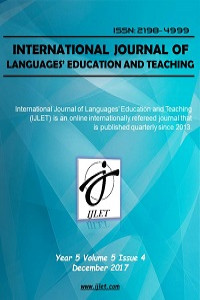Abstract
In today’s global world, the rising role of communication paves the way for developing language teaching process. One of the most important factors in language teaching is considering language as a whole. It is not only a set of rules, instead it is developing and changing, as well as the culture of the community. The cultural side of language is a significant part of language teaching but generally ignored. The purpose of this study is to determine the effects of using reading texts in the book titled ‘Select Readings’ to teach cultural elements in EFL classes for 1st grade students at university. For the study carried out during the academic year of 2011-2012, 30 students studying at 1st grade have been chosen randomly. In order to test the development of cultural knowledge between the pre-test and post-test applications of the students, who participated in the study, a cultural knowledge testing is used that has been designed by the researcher. The research has been conducted with pre-test post-test model without a control group method; for the analysis of the findings SPSS 15.0 software program has been used. When the results of the test which has been designed by the researcher and conducted before and after the activities analyzed, the findings are gathered. At the end of the study it is concluded that there is a significant effect of teaching cultural elements in reading texts to the cultural knowledge of the university students.
References
- Brown,H.D. (1994). Principles of language learning and teaching. Englewood Cliffs. N.J. : Prentice-Hall.
- Byram, M. & Risager, K. (1999). Language teachers, politics and cultures. Bristol, PA: Multilingual Matters
- Erten, İ. H., & Razı, S. (2009). The effects of cultural familiarity on reading comprehension. Reading in a Foreign Language, 21(1), 60¬-77.
- Griswold, W. (2008). Cultures and societies in a changing world. Thousand Oaks, CA: Pine Forge Press
- İlter,B.G. & Güzeller,C.O. (2005). Cultural problems of Turkish students while learning English as a foreign language. Dil Dergisi, Vol:127
- Karabınar, S. & Yunuslar Güler, C. (2012). The attitudes of EFL teachers towards teaching culture and their classroom practices. JESR, Vol:2
- Korkmaz, İ. (2009). ‘‘A Descriptive Study on the Concept of Culture and Multiculturalism in English Language Coursebooks’’. Master’s Thesis, Edirne. Trakya University Institute of Social Sciences.
- Kramsch, C. (1993). Context and culture in language teaching. Oxford: Oxford University Press.
- Kuang, J. F. (2007). Developing students’ cultural awareness through foreign language teaching. Sino-US English Teaching, 4(12), 74-81.
- Larsen-Freeman, D. (2000). Techniques and principles in language teaching. Oxford: Oxford University Press.
- Oguro, Y. (2008). ‘‘Presentation of culture in English as a foreign language reading textbooks in Japan’’. M.A. Thesis. Submitted to the Faculty of Virginia Polytechnic Institute and State University
- Sardi, C. (2002). On the relationship between culture and ELT. Kalbu Studijos/ Studies about Languages, 3, 101-107.
- Tomalin, B. & Stempleski, S. (1993). Cultural awareness. Oxford: Oxford University Press.
- Tylor, E. B. (1871). Primitive cultures. London: John Murley
Abstract
References
- Brown,H.D. (1994). Principles of language learning and teaching. Englewood Cliffs. N.J. : Prentice-Hall.
- Byram, M. & Risager, K. (1999). Language teachers, politics and cultures. Bristol, PA: Multilingual Matters
- Erten, İ. H., & Razı, S. (2009). The effects of cultural familiarity on reading comprehension. Reading in a Foreign Language, 21(1), 60¬-77.
- Griswold, W. (2008). Cultures and societies in a changing world. Thousand Oaks, CA: Pine Forge Press
- İlter,B.G. & Güzeller,C.O. (2005). Cultural problems of Turkish students while learning English as a foreign language. Dil Dergisi, Vol:127
- Karabınar, S. & Yunuslar Güler, C. (2012). The attitudes of EFL teachers towards teaching culture and their classroom practices. JESR, Vol:2
- Korkmaz, İ. (2009). ‘‘A Descriptive Study on the Concept of Culture and Multiculturalism in English Language Coursebooks’’. Master’s Thesis, Edirne. Trakya University Institute of Social Sciences.
- Kramsch, C. (1993). Context and culture in language teaching. Oxford: Oxford University Press.
- Kuang, J. F. (2007). Developing students’ cultural awareness through foreign language teaching. Sino-US English Teaching, 4(12), 74-81.
- Larsen-Freeman, D. (2000). Techniques and principles in language teaching. Oxford: Oxford University Press.
- Oguro, Y. (2008). ‘‘Presentation of culture in English as a foreign language reading textbooks in Japan’’. M.A. Thesis. Submitted to the Faculty of Virginia Polytechnic Institute and State University
- Sardi, C. (2002). On the relationship between culture and ELT. Kalbu Studijos/ Studies about Languages, 3, 101-107.
- Tomalin, B. & Stempleski, S. (1993). Cultural awareness. Oxford: Oxford University Press.
- Tylor, E. B. (1871). Primitive cultures. London: John Murley
Details
| Primary Language | English |
|---|---|
| Subjects | English As A Second Language, Applied Linguistics and Educational Linguistics |
| Journal Section | Research Article |
| Authors | |
| Publication Date | December 30, 2017 |
| Published in Issue | Year 2017 Volume: 5 Issue: 4 |


